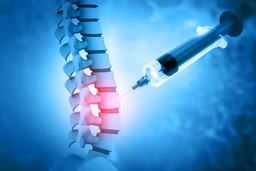A Hand-Held, Directional, Multi-Frequency Probe for Spinal Needle Placement
TECHNOLOGY NUMBER: 2018-286

OVERVIEW
A portable guidance device to improve spinal needle placement- Includes a position sensor to guide placement and avoid bone
- Cost effective, easy to use, and fits into existing workflows
BACKGROUND
Epidural injections allow the delivery of drugs, like anesthetics and steroids, into a narrow space near the spinal cord. Many procedures, including anesthesia used during childbirth, require the accurate and reliable insertion of the needle into the epidural space while avoiding adjacent, critical structures. Incorrect needle placement can cause complications including inadequate pain relief, post-dural puncture headaches, or nerve damage. This procedure is technically difficult, and most doctors still utilize a ‘blind’ approach without the use of assistive technology to place the needle. Using this method, the operator advances the needle against the dura until they ‘feel a pop’ or perceive a ‘loss of resistance’, suggesting arrival of the needle into the intradural space. As a result, approximately 30% of spinal needle insertions are initially misplaced, leading to longer procedure times, patient discomfort, and higher costs. As such, a need exists for improved methods to place needles for epidural injections.
INNOVATION
Researchers have created a portable guidance device that uses built-in sensors to improve spinal needle placement. The device includes an actuator that applies multi-frequency force to the tissue via a probe while a blunt inter-needle probe extends past the needle and uses a force sensor to record tissue resistance. A position sensor simultaneously records the distance between the blunt probe and needle while an electronic processor translates the information to determine the tissue type. One important upshot of this alignment is that the presence of bone can be detected, and therefore avoided. The operator slowly guides the needle containing a probe into the patient, with force periodically applied by the actuator to push the probe past the needle to sense resistance. Once the display reveals that the needle is close to its target, the probe and device are removed and the needle is placed in the correct space. Unlike ultrasound-based guidance approaches which are costly and require additional training, this device is cost-effective, easy to use, and fits into the existing workflow of epidural injections.